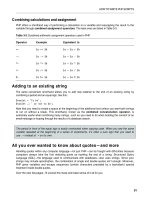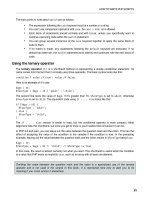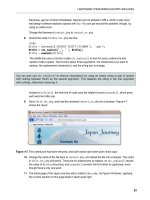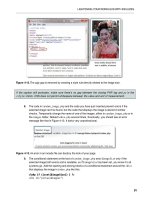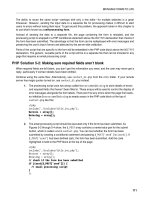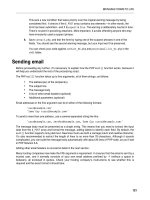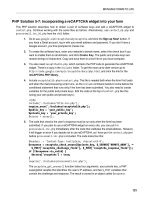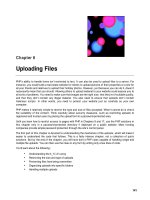Giải pháp thiết kế web động với PHP - p 8 doc
Bạn đang xem bản rút gọn của tài liệu. Xem và tải ngay bản đầy đủ của tài liệu tại đây (603.49 KB, 10 trang )
HOW TO WRITE PHP SCRIPTS
51
Combining calculations and assignment
PHP offers a shorthand way of performing a calculation on a variable and reassigning the result to the
variable through combined assignment operators. The main ones are listed in Table 3-3.
Table 3-3. Combined arithmetic assignment operators used in PHP
Operator Example Equivalent to
+= $a += $b $a = $a + $b
-= $a -= $b $a = $a - $b
*= $a *= $b $a = $a * $b
/= $a /= $b $a = $a / $b
%= $a %= $b $a = $a % $b
Adding to an existing string
The same convenient shorthand allows you to add new material to the end of an existing string by
combining a period and an equal sign, like this:
$hamlet = 'To be';
$hamlet .= ' or not to be';
Note that you need to create a space at the beginning of the additional text unless you want both strings
to run on without a break. This shorthand, known as the combined concatenation operator, is
extremely useful when combining many strings, such as you need to do when building the content of an
email message or looping through the results of a database search.
The period in front of the equal sign is easily overlooked when copying code. When you see the same
variable repeated at the beginning of a series of statements, its often a sure sign that you need to
use
.=
instead of
=
on its own.
All you ever wanted to know about quotes—and more
Handling quotes within any computer language—not just PHP—can be fraught with difficulties because
computers always take the first matching quote as marking the end of a string. Structured Query
Language (SQL)—the language used to communicate with databases—also uses strings. Since your
strings may include apostrophes, the combination of single and double quotes isnt enough. Moreover,
PHP gives variables and escape sequences (certain characters preceded by a backslash) special
treatment inside double quotes.
Over the next few pages, Ill unravel this maze and make sense of it all for you.
CHAPTER 3
52
How PHP treats variables inside strings
Choosing whether to use double quotes or single quotes might just seem like a question of personal
preference, but theres an important difference in the way that PHP handles them.
• Anything between single quotes is treated literally as text.
• Double quotes act as a signal to process variables and special characters known as escape
sequences.
Take a look at the following examples to see what this means. In the first example (the code is in
quotes1.php), $name is assigned a value and then used in a single-quoted string. As you can see from
the screenshot alongside the code, $name is treated like normal text.
$name = 'Dolly';
// Single quotes: $name is treated as literal text
echo 'Hello, $name';
If you replace the single quotes in the final line with double ones (see quotes2.php), $name is processed
and its value is displayed onscreen.
$name = 'Dolly';
// Double quotes: $name is processed
echo "Hello, $name";
In both examples, the string in the first line is in single quotes. What causes the variable to be
processed is the fact that its in a double-quoted string, not how it originally got its value.
Because double quotes are so useful in this way, many people use them all the time. Technically
speaking, using double quotes when you dont need to process any variables is inefficient. My preference
is to use single quotes unless the string contains variables.
Using escape sequences inside double quotes
Double quotes have another important effect: they treat escape sequences in a special way. All escape
sequences are formed by placing a backslash in front of a character. Most of them are designed to avoid
conflicts with characters that are used with variables, but three of them have special meanings: \n inserts
a new line character, \r inserts a carriage return, and \t inserts a tab. Table 3-4 lists the main escape
sequences supported by PHP.
Download from Wow! eBook <www.wowebook.com>
HOW TO WRITE PHP SCRIPTS
53
Table 3-4. The main PHP escape sequences
Escape sequence Character represented in double-quoted string
\"
Double quote
\n
New line
\r
Carriage return
\t
Tab
\\
Backslash
\$
Dollar sign
\{
Opening curly brace
\}
Closing curly brace
\[
Opening square bracket
\]
Closing square bracket
With the exception of
\\
, the escape sequences listed in Table 3-4, work only in double-quoted
strings. If you use them in a single-quoted string, they will be treated as a literal backslash followed
by the second character. A backslash at the end of the string always needs to be escaped.
Otherwise, its interpreted as escaping the following quotation mark. In a single-quoted string, escape
single quotes and apostrophes with a backslash as described in the first half of this chapter.
Avoiding the need to escape quotes with heredoc syntax
Using a backslash to escape one or two quotation marks isnt a great burden, but I frequently see
examples of code where backslashes seem to have run riot. It must be difficult to type, and its certainly
difficult to read. Moreover, its totally unnecessary. The PHP heredoc syntax offers a relatively simple
method of assigning text to a variable without any special handling of quotes.
The name “heredoc” is derived from here-document, a technique used in Unix and Perl programming
to pass large amounts of text to a command.
CHAPTER 3
54
Assigning a string to a variable using heredoc involves the following steps:
1. Type the assignment operator, followed by <<< and an identifier. The identifier can be any
combination of letters, numbers, and the underscore, as long as it doesnt begin with a
number. The same combination is used later to identify the end of the heredoc.
2. Begin the string on a new line. It can include both single and double quotes. Any variables will
be processed in the same way as in a double-quoted string.
3. Place the identifier on a new line after the end of the string. Nothing else should be on the same
line, except for a final semicolon. Moreover, the identifier must be at the beginning of the line;
it cannot be indented.
Its a lot easier when you see it in practice. The following simple example can be found in heredoc.php in
the files for this chapter:
$fish = 'whiting';
$mockTurtle = <<< Gryphon
"Will you walk a little faster?" said a $fish to a snail.
"There's a porpoise close behind us, and he's treading on my tail."
Gryphon;
echo $mockTurtle;
In this example, Gryphon is the identifier. The string begins on the next line, and the double quotes are
treated as part of the string. Everything is included until you reach the identifier at the beginning of a new
line. As you can see from the following screenshot, the heredoc displays the double quotes and
processes the $fish variable.
To achieve the same effect without using the heredoc syntax, you need to add the double quotes and
escape them like this:
$fish = 'whiting';
$mockTurtle = "\"Will you walk a little faster?\" said a $fish to a snail.
\"There's a porpoise close behind us, and he's treading on my tail.\""
echo $mockTurtle;
The heredoc syntax is mainly of value when you have a long string and/or lots of quotes. Its also useful if
you want to assign an XML document or a lengthy section of HTML to a variable.
PHP 5.3 introduced a related technique called nowdoc syntax, which treats variables in the same
way as single quotes—in other words, as literal text. To create a string using nowdoc syntax,
enclose the identifier in single quotes like this:
<<< 'Gryphon'
. The closing identifier does not use
quotes. For more details, see
/>.
HOW TO WRITE PHP SCRIPTS
55
Creating arrays
As explained earlier, there are two types of arrays: indexed arrays, which use numbers to identify each
element, and associative arrays, which use strings. You can build both types by assigning a value directly
to each element. Lets take another look at the $book associative array:
$book['title'] = 'PHP Solutions: Dynamic Web Design Made Easy, Second Edition';
$book['author'] = 'David Powers';
$book['publisher'] = 'friends of ED';
$book['ISBN'] = '978-1-4302-3249-0';
To build an indexed array the direct way, use numbers instead of strings as the array keys. Indexed
arrays are numbered from 0, so to build the $shoppingList array depicted in Figure 3-3, you declare it
like this:
$shoppingList[0] = 'wine';
$shoppingList[1] = 'fish';
$shoppingList[2] = 'bread';
$shoppingList[3] = 'grapes';
$shoppingList[4] = 'cheese';
Although both are perfectly valid ways of creating arrays, its a nuisance to have to type out the variable
name each time, so theres a much shorter way of doing it. The method is slightly different for each type of
array.
Using array() to build an indexed array
Instead of declaring each array element individually, you declare the variable name once and assign all
the elements by passing them as a comma-separated list to array(), like this:
$shoppingList = array('wine', 'fish', 'bread', 'grapes', 'cheese');
The comma must go outside the quotes, unlike American typographic practice. For ease of reading, I
have inserted a space following each comma, but its not necessary to do so.
PHP numbers each array element automatically, beginning from 0, so this creates exactly the same array
as if you had numbered them individually. To add a new element to the end of the array, use a pair of empty
square brackets like this:
$shoppingList[] = 'coffee';
PHP uses the next number available, so this becomes $shoppingList[5].
Using array() to build an associative array
The shorthand way of creating an associative array uses the => operator (an equal sign followed by a
greater-than sign) to assign a value to each array key. The basic structure looks like this:
$arrayName = array('key1' => 'element1', 'key2' => 'element2');
CHAPTER 3
56
So, this is the shorthand way to build the $book array:
$book = array(
'title' => 'PHP Solutions: Dynamic Web Design Made Easy, Second Edition',
'author' => 'David Powers',
'publisher' => 'friends of ED',
'ISBN' => '978-1-4302-3249-0');
Its not essential to align the => operators like this, but it makes code easier to read and maintain.
Using array() to create an empty array
There are two reasons you might want to create an empty array, as follows:
• To create (or initializ e) an array so that its ready to have elements added to it inside a loop
• To clear all elements from an existing array
To create an empty array, simply use array() with nothing between the parentheses, like this:
$shoppingList = array();
The $shoppingList array now contains no elements. If you add a new one using $shoppingList[], it will
automatically start numbering again at 0.
Multidimensional arrays
Array elements can store any data type, including other arrays. For instance, the $book array holds
details of only one book. It might be more convenient to create an array of arrays—in other words, a
multidimensional array—containing details of several books, like this:
$books = array(
array(
'title' => 'PHP Solutions: Dynamic Web Design Made Easy, Second Edition',
'author' => 'David Powers',
'publisher' => 'friends of ED',
'ISBN' => '978-1-4302-3249-0'),
array(
'title' => 'Beginning PHP and MySQL: From Beginner to Professional,
Fourth Edition',
'author' => 'W. Jason Gilmore',
'publisher' => 'Apress',
'ISBN' => 978-1-4302-3114-1')
);
This example shows associative arrays nested inside an indexed array, but multidimensional arrays can
nest either type. To refer to a specific element, use the key of both arrays, for example:
$books[1]['author'] // value is 'W. Jason Gilmore'
Working with multidimensional arrays isnt as difficult as it first looks. The secret is to use a loop to get to
the nested array. Then, you can work with it in the same way as an ordinary array. This is how you handle
the results of a database search, which is normally contained in a multidimensional array.
HOW TO WRITE PHP SCRIPTS
57
Using print_r() to inspect an array
To inspect the content of an array during testing, pass the array to print_r() like this (see
inspect_array1.php):
print_r($books);
Load inspect_array1.php into a browser to see how print_r() outputs the contents of an ordinary
array. The following screenshot shows how PHP displays a multidimensional array. Often, it helps to
switch to Source view to inspect the details, as browsers ignore indenting in the underlying output.
Alternatively, add HTML <pre> tags outside the PHP code block to preserve the indenting.
Always use
print_r()
to inspect arrays;
echo
and
dont work. To display the contents of an
array in a web page, use a
foreach
loop, as described later in this chapter.
The truth according to PHP
Decision-making in PHP conditional statements is based on the mutually exclusive Boolean values, true
and false. If the condition equates to true, the code within the conditional block is executed. If false,
its ignored. Whether a condition is true or false is determined in one of these ways:
CHAPTER 3
58
• A variable set explicitly to one of the Boolean values
• A value PHP interprets implicitly as true or false
• The comparison of two non-Boolean values
Explicit Boolean values
If a variable is assigned the value true or false and used in a conditional statement, the decision is
based on that value. The keywords true and false are case-insensitive and must not be enclosed in
quotes, for example:
$OK = false;
if ($OK) {
// do something
}
The code inside the conditional statement wont be executed, because $OK is false.
Implicit Boolean values
Using implicit Boolean values provides a convenient shorthand, although it has the disadvantage—at
least to beginners—of being less clear. Implicit Boolean values rely on PHPs relatively narrow definition
of what it regards as false, namely:
• The case-insensitive keywords false and null
• Zero as an integer (0), a floating-point number (0.0), or a string ('0' or "0")
• An empty string (single or double quotes with no space between them)
• An empty array
• SimpleXML objects created from empty tags
Everything else is true.
This definition explains why
"false"
(in quotes) is interpreted by PHP as
true
.
Making decisions by comparing two values
Most true/false decisions are based on a comparison of two values using comparison operators.
Table 3-5 lists the comparison operators used in PHP.
Table 3-5. PHP comparison operators used for decision-making
Symbol Name Example Result
==
Equality
$a == $b
Returns true if $a and $b are equal; otherwise, returns
false.
!=
Inequality
$a != $b
Returns true if $a and $b are different; otherwise, returns
false.
HOW TO WRITE PHP SCRIPTS
59
Symbol Name Example Result
===
Identical
$a === $b
Determines whether $a and $b are identical. They must not
only have the same value but also be of the same data type
(e.g., both integers).
!==
Not identical
$a !== $b
Determines whether $a and $b are not identical (according to
the same criteria as the previous operator).
>
Greater than
$a > $b
Returns true if $a is greater than $b.
>=
Greater than or
equal to
$a >= $b
Returns true if $a is greater than or equal to $b.
<
Less than
$a < $b
Returns true if $a is less than $b.
<=
Less than or
equal to
$a <= $b
Returns true if $a is less than or equal to $b.
When comparing two values, you must always use the equality operator (
==
), the identical operator
(
===
), or their negative equivalents (
!=
and
!==
). A single equal sign assigns a value; it doesnt
perform comparisons.
Testing more than one condition
Frequently, comparing two values is not enough. PHP allows you to set a series of conditions using
logical operators to specify whether all, or just some, need to be fulfilled.
The most important logical operators in PHP are listed in Table 3-6. The logical Not operator applies to
individual conditions rather than a series.
Table 3-6. The main logical operators used for decision-making in PHP
Symbol Name Example Result
&&
And
$a && $b
Equates to true if both $a and $b are true.
||
Or
$a || $b
Equates to true if either $a or $b is true; otherwise, false.
!
Not
!$a
Equates to true if $a is not true.
Technically speaking, there is no limit to the number of conditions that can be tested. Each condition is
considered in turn from left to right, and as soon as a defining point is reached, no further testing is carried
out. When using &&, every condition must be fulfilled, so testing stops as soon as one turns out to be
CHAPTER 3
60
false. Similarly, when using ||, only one condition needs to be fulfilled, so testing stops as soon as one
turns out to be true.
$a = 10;
$b = 25;
if ($a > 5 && $b > 20) // returns true
if ($a > 5 || $b > 30) // returns true, $b never tested
You should always design your tests to provide the speediest result. If all conditions must be met,
evaluate the one most likely to fail first. If only one condition needs to be met, evaluate the one most likely
to succeed first. If a set of conditions needs to be considered as a group, enclose them in parentheses.
if (($a > 5 && $a < 8) || ($b > 20 && $b < 40))
PHP also uses
AND
in place of
&&
and
OR
in place of
||
. However, they arent exact equivalents. To
avoid problems, its advisable to stick with
&&
and
||
.
Using the switch statement for decision chains
The switch statement offers an alternative to if . . . else for decision making. The basic structure
looks like this:
switch(
variable being tested
) {
case
value1
:
statements to be executed
break;
case v
alue2
:
statements to be executed
break;
default:
statements to be executed
}
The case keyword indicates possible matching values for the variable passed to switch(). Each
alternative value must be preceded by case and followed by a colon. When a match is made, every
subsequent line of code is executed until the break keyword is encountered, at which point the switch
statement comes to an end. A simple example follows:
switch($myVar) {
case 1:
echo '$myVar is 1';
break;
case 'apple':
case 'banana':
case 'orange':
echo '$myVar is a fruit';
break;
default:
echo '$myVar is neither 1 nor a fruit';
}
